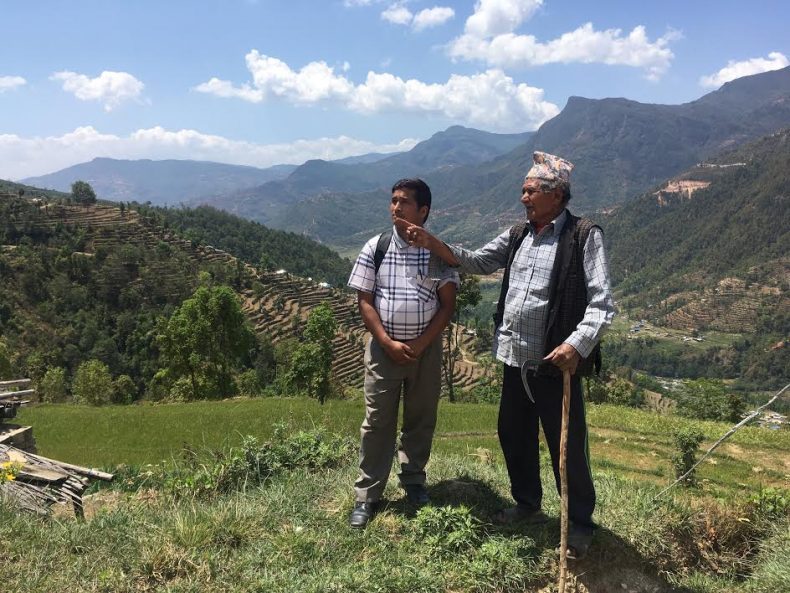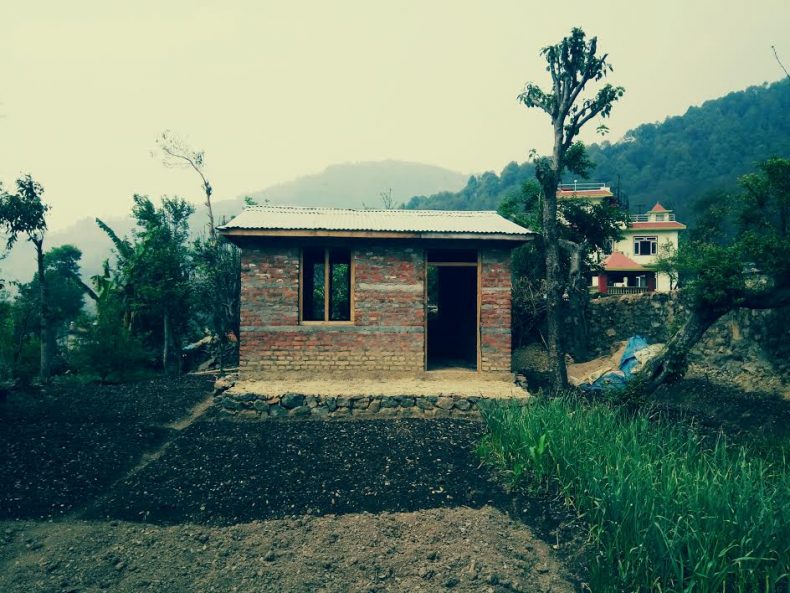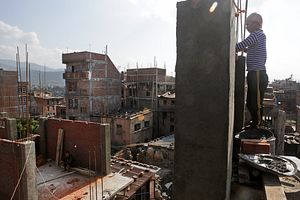Sindhupalchok District, Province 3, Nepal — The village of Sunkhani, located on a ridge overlooking a verdant valley several hours’ drive north of Kathmandu, was abuzz with the sounds of construction on a recent morning; the calls of cuckoos and other birds mixed with the clang of hammers and the buzz of electric saws. To the north, the mountain Jugal Himal shone brilliantly in the springtime sun.
Most people in Sunkhani have been living in temporary sheds made from wood and tin since devastating earthquakes destroyed their homes three years ago today. The earthquakes killed nearly 9,000 and destroyed over 750,000 homes across the country – mostly in rural areas. But now, many people are finally rebuilding.
Standing near her under-construction four-room house, Dolma Dong, 42, explained how her family financed the rebuilding: in addition to putting in all their savings, they sold their water buffalo and took out loans from a local money-lender. “We built a bit, took out loans, and then built a bit more.”
Though the government provides a subsidy of approximately $3,000 per household, in most cases this covers only a portion of costs. Dong says her home reconstruction will cost nearly $10,000. She is among nearly two-thirds of earthquake victims who took out loans for reconstruction last year, according to a UN study.
Nepal has witnessed a dramatic spurt in progress in home reconstruction over the past few months, driven in part by government deadlines announced last year. In order to remain eligible for the subsidy grants, earthquake victims must complete construction of their homes up to the plinth level and receive certification by a government engineer by mid-July. So far, roughly half of eligible households have done so. Although the government expects that most earthquake victims will be able to meet the deadlines, some fear that vulnerable populations — including the poorest, who must borrow to reconstruct — are at risk of being left behind.

Photo caption: Madhav Dhakal (left), a volunteer with the Sindhupalchok Land Rights Forum, and Sobha Ram Bishwokarma, an earthquake victim, in Chitre village, near Sunkhani. Photo by Peter Gill.
Deadlines Aim to Speed up Recovery
In the years following the 2015 quakes, recovery has been much slower than many hoped. The government estimated total recovery needs at over $8 billion, out of which it has spent approximately $1.1 billion so far. (Roughly half came from internal sources, and half from external grants and loans — donors have pledged a total of $4.1 billion although over $600 million was for immediate rescue and relief.) Rebuilding in the housing sector — which represents nearly half of the government’s recovery costs — has been especially sluggish.
Amid criticism from donors and others about the slow pace of recovery, the government announced deadlines for housing reconstruction last year. Initially, the government said that houses must be completed by July 2018, although it has since revised deadlines: victims must complete homes up to the plinth-level by mid-July 2018 and up to the roof-line by mid-January 2019, according to Dr. Bhisma Bhusal, a spokesperson for the National Reconstruction Authority, or NRA, the government agency overseeing the process.
The slow pace of housing recovery is due to a variety of factors. It took nearly a year to complete the survey of damaged households and establish victim lists. The NRA was only established in December 2015 — nearly eight months after the earthquakes hit. Meanwhile, aftershocks continued long after the initial quake, and annual monsoon rains and a lack of roads to quake-hit areas complicated reconstruction. Political factors played a role, too: an unofficial four-and-a-half month blockade by India in 2015-16 squeezed supply lines; local, provincial, and national-level elections in 2017 created distractions and delays; and a government devolution process currently underway has sometimes created administrative confusion. In many areas, there was an initial lack of trained manpower and government engineer-inspectors to ensure that reconstruction followed building code.
Victims Go Into Debt
But the delays are also due to household-level factors.
Earthquake victims play the key role in the government’s owner-driven housing reconstruction program. Developed in consultation with the World Bank, its largest lender, the program gives home-owners subsidy grants in three tranches as they demonstrate progress in rebuilding their own homes according to official building code. A recent learning document by the Housing Recovery and Reconstruction Platform, or HRRP, an organization that assists the government, advised aid workers: “Owner driven reconstruction will move at the pace of households; don’t think you can fully plan or control shelter or housing, you have to continuously respond to the momentum people drive themselves.”
According to a 2017 study by the Asia Foundation, the most common obstacle to reconstruction is home owners’ lack of financial resources. The median cost of rebuilding a home is approximately $6,750, significantly more than the government grant, according to a survey by HRRP.
Costs of building have increased dramatically since the earthquake, and especially since deadlines were announced, due to soaring demand for materials and labor. For example, in Sunkhani, locals say that the daily wage for masons has increased from 800 rupees (roughly $8) per day before the earthquake to 1300 rupees ($13) per day now.
Some households have been able to afford rebuilding their homes by utilizing their own resources combined with the government subsidy. And in some communities, people are able to save money by buying materials together and pooling labor.
But for the majority of households, financing reconstruction remains a serious challenge.
According to the HRRP, in an increasing trend, people are rebuilding one-room houses in order to meet the government deadlines and receive the subsidy. Such tiny houses usually don’t meet the spatial needs of agricultural households, which require room to store crops, livestock, and tools.
Others are financing rebuilding by sending family members to work abroad in the Middle East, Malaysia, or elsewhere. Although Nepal’s overall out-migration rate has fallen slightly in recent years (partly due to the falling price of oil and economic slowdown in the Gulf, a primary destination), migration from areas worst-hit by the earthquakes is increasing, according to the Asia Foundation study: households in earthquake-affected areas depending on remittances increased from 9 percent in 2015 to 15 percent in 2017.
In Baaskharka village, several kilometers northeast of Sunkhani, Indra Bahadur Shrestha, 74, was one of the first to complete rebuilding his home using remittance income. Shrestha and his wife are in the process of moving into their two rooms, which are covered with a blue tin roof and fronted by a small veranda. Shrestha says the total cost was roughly $6,000, paid for by his son, who has worked in Israel for several years.
But an even more common financial strategy is to take out a loan to rebuild. According to a study by the UN Resident Coordinator’s Office, nearly two-thirds of earthquake victims took out loans in 2017 to finance reconstruction.
While the government has a low-interest loan program for earthquake victims, few have been able to access it. Under the program, the central bank provides funds at zero interest to commercial and development banks, which then loan out the funds to victims at 2 percent per annum. However, the for-profit banks have little financial incentive to participate, since the process requires significant paperwork and human resources. According to Bhusal, the NRA spokesperson, only about 800 low-interest loans have been given so far, mostly in Kathmandu Valley.
Regular bank loans — at over 10 percent interest — are often equally inaccessible for rural earthquake victims. Nepal is in the midst of a credit crunch, and banks prefer to loan to borrowers who can put up urban land as collateral. “If you show that you have land in [rural] Sindhupalchok District for your collateral, no bank is eager to provide you the loan,” explains Bhusal.
As a result, most earthquake victims turn to informal loans from local moneylenders — typically at 25 percent per annum, sometimes as high as 36 percent.
Daniel Coyle, the country director of People in Need, an international NGO working in recovery, explains that Nepal has a painful history of the poor becoming stuck in intergenerational cycles of debt. In the past, lenders, who were often local landlords, sometimes took advantage of the poor, illiterate, and so-called low-castes, who could not read the agreements they signed. While conditions have improved — literacy has spread and many lenders are now shopkeepers, traders, or simply neighbors with disposable income — debt still poses hazards.
“If people are going further into debt as a result of the earthquake, it poses longer-term questions about their life chances — whether their kids will be able to pursue and get a good education, and what that really meant for the families’ strategies,” says Coyle.

Photo caption: A one-room home in Sisneri, Mahalaxmi Municipality, Lalitpur, Province 3. In an increasing trend, earthquake victims are building tiny houses that do not necessarily meet needs, in order to access government housing subsidy grants. Photo Credit: Housing Recovery and Reconstruction Platform
Rushing to Make the Deadline
Although the NRA has already extended the deadline for households to receive the second tranche of funds, Bhusal says it is unlikely to do so again, even if this means that some households will be left out.
Unofficially, sources within the NRA and in the donor community say that if 80 percent of households rebuild, the NRA will consider it a success. In a recent presentation to donors, the NRA claimed that 75 percent of homes were either under construction or complete, although only about half of all homes have been deemed eligible for the second tranche, signifying they are rebuilding according to code.
Bhusal says that some potential beneficiaries of the grant program have migrated away from their villages and are no longer interested in rebuilding, while others are illegitimate recipients who got onto victims’ lists due to local political pressure.
“The local politicians were targeting the [2017] elections,” Bhusal says. “The more number of beneficiaries you can produce, the more votes.”
However, the incidence of fraudulent beneficiaries or those who elect not to rebuild is a subject of debate. Rights groups such as Amnesty International have argued that the slowest to rebuild are often the most vulnerable, such as women-headed households, households without young people, people with disabilities, and the poor.
“After the earthquake, the government took the view that everyone is equal… The earthquake affected everyone, but the most affected were Dalits [so-called untouchables] and other weaker classes,” notes Madhav Dhakal, 30, a volunteer with the Sindhupalchok Land Rights Forum, who has been helping vulnerable groups sign up for and access government funds.
The government has responded to criticisms with some efforts to better accommodate needs. The grant program — originally for $2,000 — was increased to $3,000 in 2016. (A lame duck government in early 2018 announced an increase to $4,000, although this decision was never officially endorsed.) A special “top-up” grant of roughly $500 is available for elderly widows, disabled people without supporters, seniors without supporters, and orphans, but this is only just beginning to be disbursed due to delays verifying recipients. The government also has a program to provide $2,000 to households at risk of landslides to buy land in secure locations, and these households are not subject to the current deadlines.
But for many people subject to the deadline, the decision comes down to whether to rush to rebuild under the government program – and probably take out a loan – or rebuild at a slower pace, without assistance from the government.

Photo caption: Shyalmo Tamang stands on top of her home’s newly-finished foundation, Baaskharka village. Credit: Peter Gill
Shyalmo Tamang, 62, of Baaskharka, stands on top of the recently-finished foundation to her four-room home. She says she applied for the second tranche of government funds, and is expecting a government inspector soon. But her family also took out a loan for around $2,000, and they expect to borrow an additional $2,000 before the home is complete.
The financial burden has been overwhelming for her.
“Our only son is just 19. It’s not time for him to go abroad yet. And so where will the money come from?” she says. “I don’t sleep well at night, thinking ‘How will I pay my loan? How will I finish my house?’”
Peter Gill is an American freelance journalist based in Nepal.

































